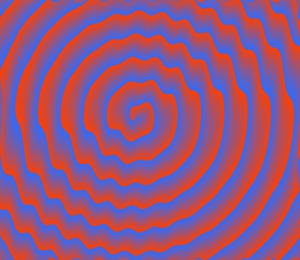 This Intermezzo might use as its title a variant of the advertising slogan for Visine eye drops: “Gets the red out!” Here it would be: “Get the red text out!”
This Intermezzo might use as its title a variant of the advertising slogan for Visine eye drops: “Gets the red out!” Here it would be: “Get the red text out!”
Amateur cover designers seem to have a penchant for using red text against blue and gray backgrounds. Almost always this is a mistake.
The problem most often is seen in two genres, horror and thrillers, but it appears elsewhere too, though seldom on the covers of non-fiction books or romance novels.
The reason isn’t hard to fathom. Red is the color of blood and of fear. Scary things come in red, not in sweet pastels. A horror story is likely to have gallons of blood spilled within its pages. A thriller will have blood-curdling scenes, even if no blood seeps from wounds. Science fiction books will have scary aliens, while suspense stories will have scary malefactors.
“Why not suggest the blood on the cover, using red type?” wonder these designers. It’s a fair question but one that usually ought to be answered this way: “Please don’t.”
The problem is that red, when used even for large type such as titles, stands out poorly against the background colors often used for most horror stories, thrillers, and other genres. Those colors are dark blue and shades of gray. There are two problems.
First, red on blue or red on gray usually means dark color on dark color, with the result that nothing pops. Second, and worse, is that red and blue clash (see the accompanying spiral for proof), and even red and gray don’t play well together.
Red type can look great on a cover, provided the red is set against a light color such as white, beige, or pale yellow. When that is done, a red title will catch the eye more deliberately than will a blue or green or brown title. The only competition, oddly enough, will be black.
I say “oddly enough” because many people think black is an unobtrusive color, one that sits at a table while the vibrant colors dance in the middle of the room. Not so, actually. Black, when put on a light-colored background, pops at least as well as red. (Conversely, on a dark background, white stands out well, often even better than the next-best color for that situation, yellow.)
As effective as red can be on a light background, it can be that ineffective on a dark background. It even can be ineffective on a background halfway between, such as sky blue (against which gold often is a better choice). Still, many amateur designers default to red on blue or red on gray. They focus too much on symbolism (blood, fear) and too little on visuals.
They think they “need” to show the typographical equivalent of blood if their book is to be seen as being in its true genre. They overlook that many of the most successful covers in categories such as horror, thrillers, suspense, and science fiction—all genres where red is widely misused—have no red on them at all.
Each designer—particularly each do-it-yourself designer—should have by the computer monitor a sticky note that says, “Get the red text out!” Following that injunction can prevent a good cover from being tagged with the kiss-of-death label “amateur.”
